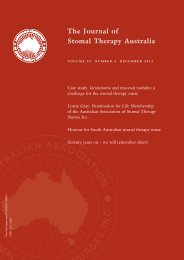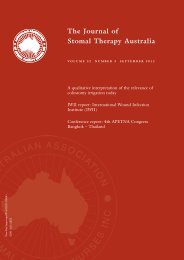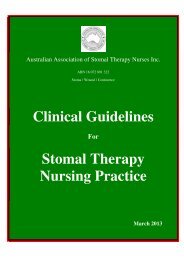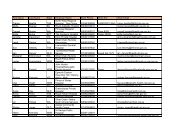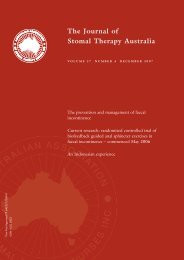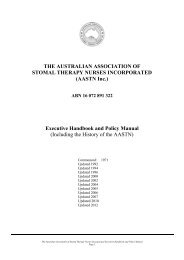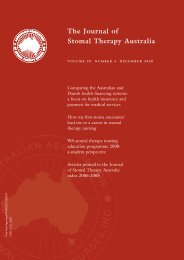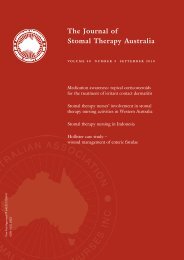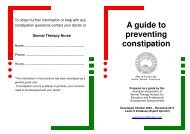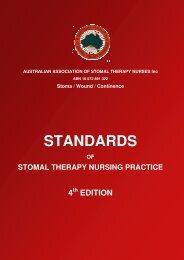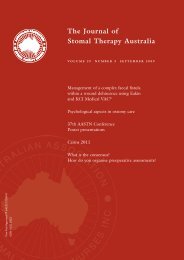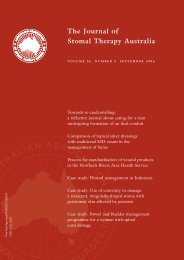JSTA December 2010 - Australian Association of Stomal Therapy ...
JSTA December 2010 - Australian Association of Stomal Therapy ...
JSTA December 2010 - Australian Association of Stomal Therapy ...
Create successful ePaper yourself
Turn your PDF publications into a flip-book with our unique Google optimized e-Paper software.
could approach for this. I spoke with other nursing colleagues, I<br />
spoke to one <strong>of</strong> the company representatives <strong>of</strong> stomal products<br />
and I spoke to the treating team (4, 5, 6, 7, 8.1). Throughout this<br />
I maintained open communication with the patient and their<br />
family to give them a feeling <strong>of</strong> acknowledgement and active<br />
participation (6.6).<br />
Throughout my stomal training it has become more evident as I<br />
continue this journey that patients and family first (PAFF) play<br />
a major role (2.1). I have only just become aware <strong>of</strong> this term<br />
but realised when I heard it how much it impacts on stomal<br />
therapy nursing (2.1, 8.3). The patient discussed earlier with the<br />
leakage issues is a good example <strong>of</strong> PAFF. I actively sought out<br />
her family and made my visits at corresponding times when<br />
they would be present. Education was given to both the patient<br />
and the family. I believe this support and involvement from her<br />
family enabled her to cope more effectively, especially when we<br />
were dealing with the leakage issues.<br />
When I first began this course I had ward experience <strong>of</strong> dealing<br />
with stomal patients and very limited experience <strong>of</strong> the actual<br />
role <strong>of</strong> the stomal nurse. At the beginning I thought it was<br />
defined as just caring for patients with stomas. I remember<br />
while I was on clinical placement with the stomal therapist<br />
and a ward ringing her to ask advice about a dehisced suture<br />
line that was having heavy output. I asked the stomal therapist<br />
why they would call her and not the wound team especially as<br />
there was no stoma involved. As she explained the rationale to<br />
me my whole conception <strong>of</strong> the role <strong>of</strong> a stomal therapist nurse<br />
changed. That moment made me realise how diverse the role is<br />
and how much it could <strong>of</strong>fer me.<br />
I believe I am now practising as an expert practitioner. This is<br />
defined by Benner 6 as having an intuitive grasp <strong>of</strong> situations<br />
and not requiring analytical rules or guidelines to facilitate<br />
this understanding. Important traits I attribute to an advanced<br />
practising nurse or expert practitioner is someone who uses<br />
their resources to their advantage. It is not a nurse who knows<br />
all the answers but one who recognises their own knowledge<br />
deficits and is comfortable to ask for direction and clarification<br />
as required. It is a nurse who is active in self-reflection.<br />
On my reflection and from taking into account the feedback I<br />
obtained from my clinical placements and working with various<br />
clinical nurse specialists, I have identified some areas I wish<br />
to further develop (9.6). Firstly I would like to become more<br />
proactive in the area <strong>of</strong> stomal therapy by attending conferences<br />
and seminars (12.1). I have taken a small step towards this by<br />
attending an education session about new stomal products<br />
outside work time (12.1). By doing this in my own time it<br />
demonstrates commitment to my ongoing education. I would<br />
also like to further develop my interpersonal skills with members<br />
<strong>of</strong> the multidisciplinary team and clients (11.1, 11.2). I believe<br />
this is an area in which I can always improve and as I do it will<br />
give me more confidence to interact with others. I feel by the<br />
development <strong>of</strong> these skills that I will be better equipped to be a<br />
role model for others. I hope to participate in more education on<br />
a larger scale in the future as well. This will be beneficial to my<br />
educational needs and those <strong>of</strong> others.<br />
coNcluSIoN<br />
This reflective essay has enabled me to conclude my journey.<br />
The course has been an enjoyable experience by allowing me to<br />
rediscover interests I wasn’t aware <strong>of</strong> or perhaps would not have<br />
considered. At times it has been challenging and my optimism<br />
wavered, but the feeling <strong>of</strong> achievement and completion always<br />
won in the end. I am glad I have completed this course as it<br />
opens many new opportunities for my career now and in the<br />
future.<br />
refereNceS<br />
1. <strong>Australian</strong> Nursing Federation. Competency standards for nurses in<br />
general practice. Advanced registered nurses. Melbourne, VIC: ANF,<br />
2005, pp. 2–7.<br />
2. Blackley P. Practical stoma wound and continence management.<br />
Australia: Research Publications, 1998.<br />
3. Carville K. Wound care manual, 5th edn. Australia: Silver Chain<br />
Nursing <strong>Association</strong>, 2007.<br />
4. Bird K. Clinical leadership. The Journal <strong>of</strong> <strong>Stomal</strong> <strong>Therapy</strong> Australia,<br />
2009; 29(3)6,8–9.<br />
5. New South Wales College <strong>of</strong> Nursing. Graduate certificate in stomal<br />
therapy nursing: course information book. Burwood: The College <strong>of</strong><br />
Nursing, 2009.<br />
6. Benner P. Interpretation <strong>of</strong> data. In: From novice to expert: Excellence<br />
and power in clinical nursing practice. Menlo Park, California:<br />
Addison-Wesley, 1984, pp. 17–34.<br />
AASTN MEMBERSHIP<br />
RENEWALS & REcEIPTS<br />
The AASTN Executive Committee would like to notify<br />
and/or remind all members:<br />
• Membership fees are due by the 31st <strong>December</strong> <strong>of</strong> each<br />
year (AASTN Constitution 2003).<br />
• Membership ceases if in arrears for 60 days. ie:<br />
1 March. (AASTN Constitution 2003).<br />
• Please note from 2011 AASTN will implement the late<br />
fee charge ($20) for members who renew later than<br />
1 April.<br />
• Late fees DO NOT APPLY to new members applying<br />
after 30th March.<br />
• AASTN’s preferred method <strong>of</strong> fee payment is by direct<br />
banking. Please consider this payment method. Your<br />
membership ID (MID) and surname should be included<br />
in the payment description for easy identification.<br />
• from 2011 receipts will not be issued unless the<br />
request is indicated on the renewal form. Preferred<br />
format <strong>of</strong> issue will be via email. Please ensure your<br />
provided email address is current.<br />
This notification by The Executive Committee has been<br />
prompted by the large number <strong>of</strong> AASTN members<br />
renewing late into the membership year, and increasing<br />
postage costs.<br />
Thank you for your understanding and cooperation. �<br />
Journal <strong>of</strong> <strong>Stomal</strong> therapy australia – Volume 30 Number 4 19



